AIRBUS Bundle
How Did Airbus Rise to Become an Aviation Titan?
The skies are filled with aircraft, but few stories are as compelling as that of Airbus. Born from a bold vision of European collaboration, Airbus challenged the established giants of the aviation industry. This journey, marked by innovation and strategic foresight, transformed the aerospace landscape. From its AIRBUS SWOT Analysis to its global dominance, Airbus's story is one of remarkable evolution.
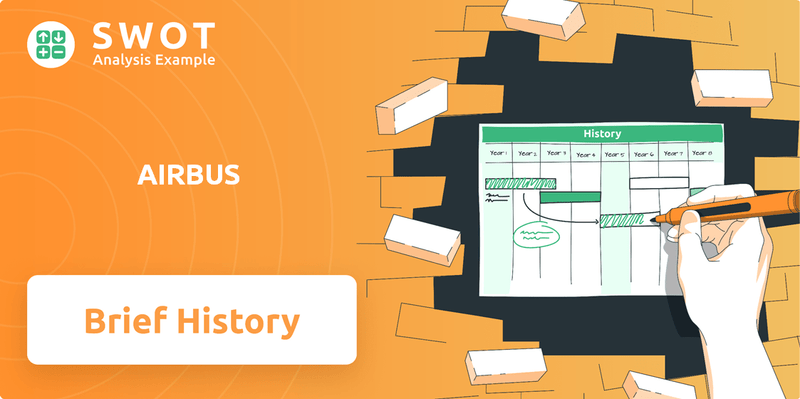
Delving into the brief history of Airbus company reveals a story of overcoming obstacles and achieving unprecedented success. From its Airbus origins as a consortium to its current status as a global aerospace leader, the Airbus timeline is filled with significant events and key milestones. Understanding Airbus's early years history and its impact on aviation provides valuable insights into the company's enduring legacy and its continued influence on the future of flight and Airbus aircraft manufacturing.
What is the AIRBUS Founding Story?
The Airbus history began on December 18, 1970, with the official formation of Airbus Industrie G.I.E. This marked a pivotal moment in the Airbus company's journey, driven by a strategic need for European collaboration in the global aerospace market. The Airbus origins are deeply rooted in the cooperative efforts of France, Germany, and the United Kingdom, aiming to challenge the dominance of American manufacturers.
The initial goal was to create a European alternative to the existing market leaders like Boeing. The consortium model allowed member companies to contribute resources and share both the risks and rewards of aircraft development. The first major project, the A300, was a direct response to the demand for a more efficient, medium-haul aircraft.
The name 'Airbus' was selected for its simplicity and global appeal, symbolizing an aircraft designed for every airline. Funding was primarily secured through government loans and investments from the participating aerospace companies. One of the early challenges was to harmonize the different national interests and engineering standards, which was overcome through extensive collaboration. For more information, you can read about the Target Market of AIRBUS.
The founding of Airbus was a strategic alliance among European nations to compete in the global aerospace market, aiming to challenge the dominance of American manufacturers. The initial focus was on developing the A300, a twin-engine, wide-body airliner, to meet the demand for more efficient aircraft.
- Airbus company founding date: December 18, 1970.
- Airbus first aircraft model: A300.
- The primary founders included France (Sud Aviation), Germany (Deutsche Aerospace), and the UK (Hawker Siddeley).
- The initial business model was a consortium, sharing risks and rewards among member companies.
AIRBUS SWOT Analysis
- Complete SWOT Breakdown
- Fully Customizable
- Editable in Excel & Word
- Professional Formatting
- Investor-Ready Format
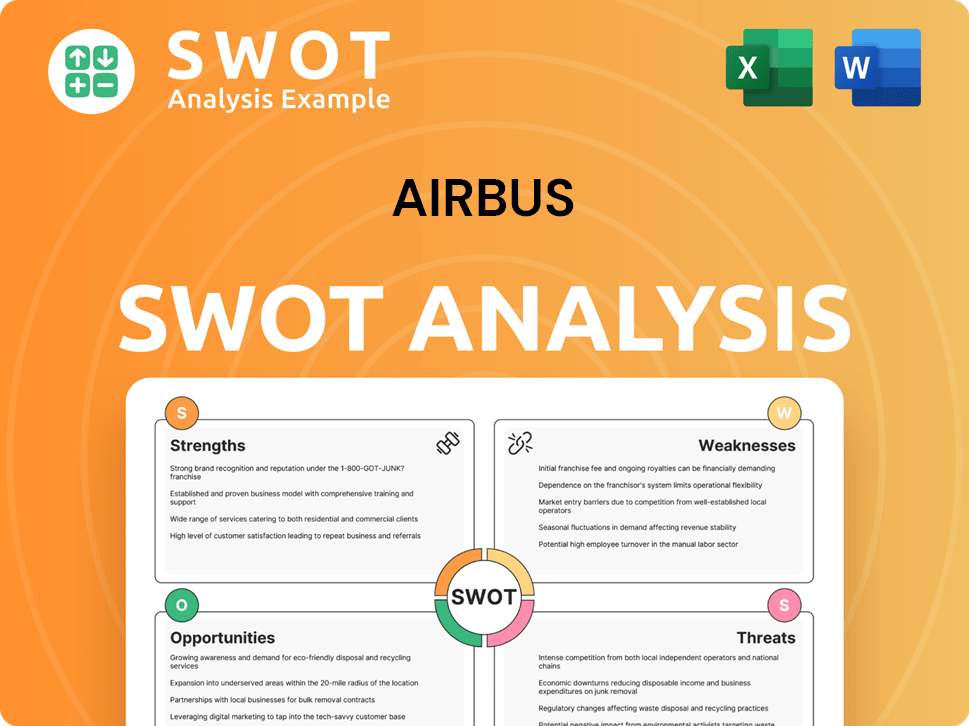
What Drove the Early Growth of AIRBUS?
The early growth of the Airbus company, a key part of the Airbus history, began with the development of its first commercial aircraft, the A300. The maiden flight of the A300 took place in October 1972, and it entered commercial service in May 1974. Despite initial challenges, Airbus gradually gained ground, particularly in the United States. This early period was crucial for establishing the Airbus origins and setting the stage for future expansion.
The A300's entry into service was a significant milestone. Initial sales were slow, but the company secured a breakthrough order from Eastern Air Lines in 1977. This order helped validate the A300's potential. The primary assembly location was established in Toulouse, France, where engineers and specialists from the founding national aerospace companies consolidated their expertise. The Airbus aircraft manufacturing process began to take shape.
Airbus expanded its product line with derivative models like the A310, launched in 1978. A pivotal moment came with the A320 family in the mid-1980s, which introduced fly-by-wire technology. The A320 became a best-seller, significantly boosting Airbus's market share. This demonstrates the Airbus company evolution.
Airbus transitioned from a consortium to a more integrated company. In 2001, Airbus Industrie G.I.E. was transformed into Airbus S.A.S., streamlining operations. The company continued to expand its global footprint, establishing sales and support offices worldwide. The Airbus company global presence grew steadily.
By 2024, Airbus reported a record 2,319 net orders for commercial aircraft, highlighting robust market reception. This underscores the company's continued growth and success. The Airbus company milestones reflect its significant impact on aviation. For more detailed information on the company's history, you can read a brief history of Airbus company.
AIRBUS PESTLE Analysis
- Covers All 6 PESTLE Categories
- No Research Needed – Save Hours of Work
- Built by Experts, Trusted by Consultants
- Instant Download, Ready to Use
- 100% Editable, Fully Customizable
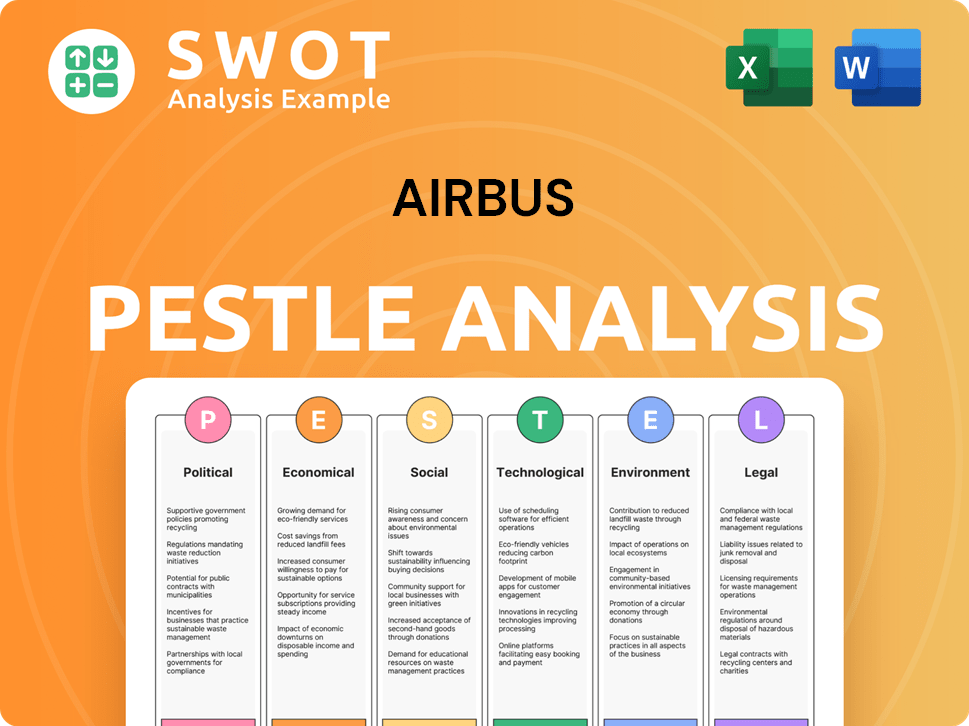
What are the key Milestones in AIRBUS history?
The Airbus history is marked by significant achievements and evolutions in the aerospace industry. From its origins as a collaborative venture to its current status as a global leader, the
| Year | Milestone |
|---|---|
| 1970 | Airbus Industrie is formally established, marking the beginning of a European collaborative effort in aircraft manufacturing. |
| 1972 | The first Airbus aircraft, the A300, takes its maiden flight, signaling the company's entry into the commercial aviation market. |
| 1987 | The A320, featuring fly-by-wire technology, is introduced, revolutionizing flight control systems and setting new safety standards. |
| 2005 | The A380, the world's largest passenger airliner, makes its first flight, aiming to address airport congestion with its massive capacity. |
| 2017 | Airbus consolidates its divisions into Airbus SE, streamlining operations and enhancing collaboration across its business segments. |
| 2021 | Production of the A380 ceases due to changing market demands and a shift towards more fuel-efficient aircraft. |
Innovations have been central to the
The introduction of fly-by-wire control systems in the A320 significantly improved flight safety and efficiency by replacing mechanical linkages with electronic systems.
Airbus has increasingly used composite materials in its aircraft designs, such as the A350, to reduce weight and improve fuel efficiency.
Airbus aircraft incorporate advanced avionics and cockpit designs, enhancing pilot situational awareness and operational efficiency.
Continuous efforts to improve fuel efficiency, including the development of more aerodynamic designs and the use of advanced engines, have been a major focus.
Airbus has prioritized passenger comfort through wider cabins, improved seating arrangements, and advanced in-flight entertainment systems.
Airbus is actively researching and developing sustainable aviation technologies, including the use of sustainable aviation fuels (SAF) and the development of hydrogen-powered aircraft, aiming to reduce the environmental impact of air travel.
Despite its successes,
Economic downturns, such as the 2008 financial crisis, have significantly impacted aircraft orders and production schedules.
Intense competition from Boeing has required Airbus to constantly innovate and adapt its strategies to maintain market share.
Delays in the production of key programs, such as the A380 and A400M, have led to financial and reputational challenges.
Shifts in airline preferences towards smaller, more fuel-efficient aircraft have impacted the demand for larger aircraft like the A380.
Disruptions to the global supply chain, particularly during events like the COVID-19 pandemic, have affected aircraft production and delivery schedules.
Geopolitical tensions and trade disputes can impact Airbus's operations, particularly in terms of sales and supply chain management.
AIRBUS Business Model Canvas
- Complete 9-Block Business Model Canvas
- Effortlessly Communicate Your Business Strategy
- Investor-Ready BMC Format
- 100% Editable and Customizable
- Clear and Structured Layout
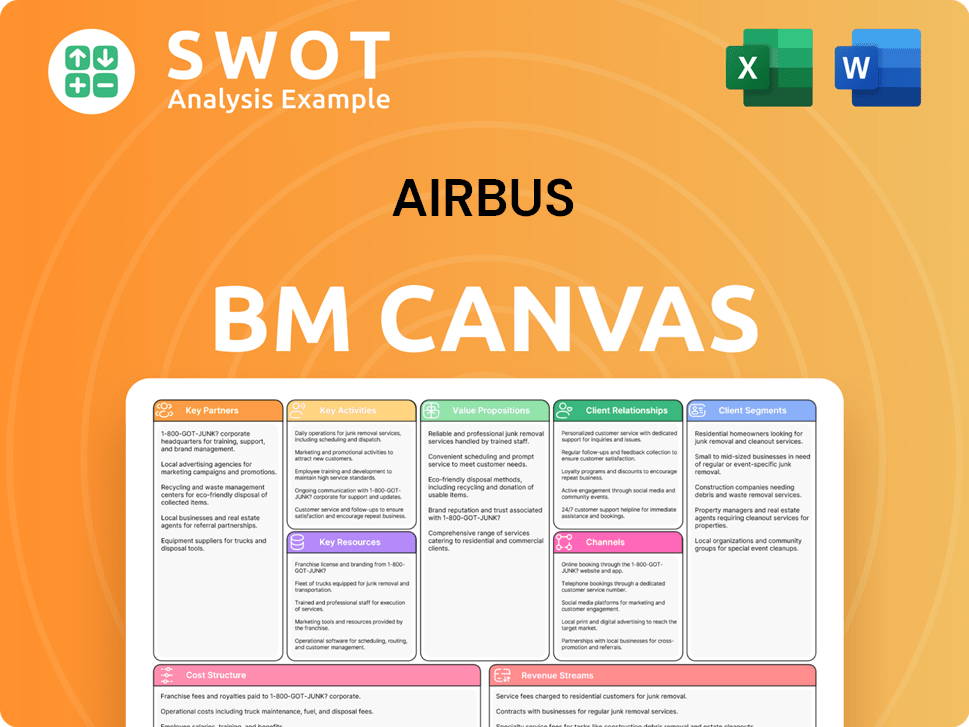
What is the Timeline of Key Events for AIRBUS?
The Airbus company has a rich history, marked by significant milestones in aviation. From its
| Year | Key Event |
|---|---|
| 1970 | Airbus Industrie G.I.E. officially formed, marking the company's founding. |
| 1972 | Maiden flight of the A300, the first twin-aisle, twin-engine airliner. |
| 1974 | The A300 entered commercial service with Air France, a pivotal moment for Airbus. |
| 1978 | Launch of the A310 program, expanding the Airbus product line. |
| 1987 | The A320, featuring fly-by-wire technology, entered service, revolutionizing aircraft control. |
| 1994 | First flight of the A330 and A340, broadening Airbus's range of aircraft. |
| 2001 | Airbus Industrie G.I.E. transformed into Airbus S.A.S., streamlining operations. |
| 2005 | First flight of the A380, the world's largest passenger airliner at the time. |
| 2006 | Airbus delivered its 4,000th aircraft, a significant manufacturing achievement. |
| 2013 | First flight of the A350 XWB, showcasing advanced composite materials and design. |
| 2017 | The company reorganized as Airbus SE, consolidating its divisions for greater efficiency. |
| 2021 | Last A380 delivered, concluding the production of this iconic aircraft. |
| 2024 | Airbus reported record commercial aircraft orders, demonstrating strong market demand. |
| 2025 | Expected ramp-up in A320 family production rates, aiming for 75 aircraft per month by 2026. |
Airbus is focused on increasing production rates to meet rising demand. The A320 family production is a key priority, with plans to reach 75 aircraft per month by 2026. This expansion reflects the company's confidence in the market and its ability to deliver. This demonstrates the company's commitment to meeting customer needs and maintaining its competitive edge in the
Airbus is heavily investing in sustainable aviation technologies. A major initiative is the development of hydrogen-powered aircraft. The goal is to introduce a zero-emission commercial aircraft by 2035, aligning with industry trends. This commitment underscores Airbus's dedication to environmental responsibility and innovation.
Airbus is expanding its digital services and defense capabilities. This diversification aims to leverage its technological expertise across various sectors. These efforts are designed to create new revenue streams. It also strengthens the company's position in the aerospace industry.
Analyst predictions generally indicate continued growth for Airbus. This growth is driven by increasing global air travel. The company is focusing on fleet modernization. Airbus's leadership emphasizes innovation and sustainability. This ensures its relevance in a changing aerospace landscape.
AIRBUS Porter's Five Forces Analysis
- Covers All 5 Competitive Forces in Detail
- Structured for Consultants, Students, and Founders
- 100% Editable in Microsoft Word & Excel
- Instant Digital Download – Use Immediately
- Compatible with Mac & PC – Fully Unlocked
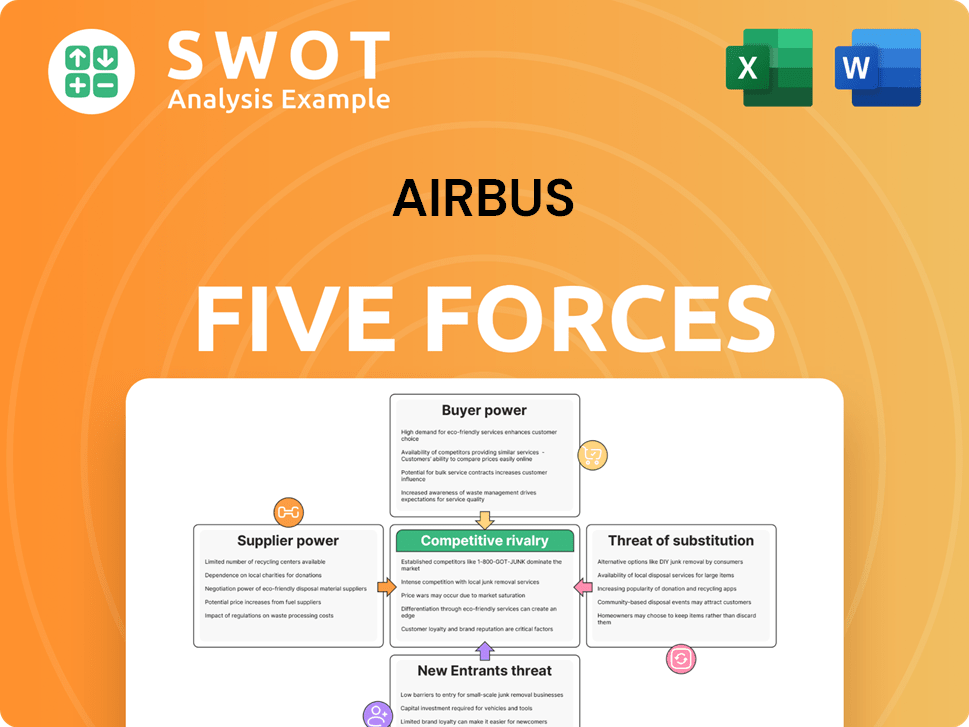
Related Blogs
- What is Competitive Landscape of AIRBUS Company?
- What is Growth Strategy and Future Prospects of AIRBUS Company?
- How Does AIRBUS Company Work?
- What is Sales and Marketing Strategy of AIRBUS Company?
- What is Brief History of AIRBUS Company?
- Who Owns AIRBUS Company?
- What is Customer Demographics and Target Market of AIRBUS Company?
Disclaimer
All information, articles, and product details provided on this website are for general informational and educational purposes only. We do not claim any ownership over, nor do we intend to infringe upon, any trademarks, copyrights, logos, brand names, or other intellectual property mentioned or depicted on this site. Such intellectual property remains the property of its respective owners, and any references here are made solely for identification or informational purposes, without implying any affiliation, endorsement, or partnership.
We make no representations or warranties, express or implied, regarding the accuracy, completeness, or suitability of any content or products presented. Nothing on this website should be construed as legal, tax, investment, financial, medical, or other professional advice. In addition, no part of this site—including articles or product references—constitutes a solicitation, recommendation, endorsement, advertisement, or offer to buy or sell any securities, franchises, or other financial instruments, particularly in jurisdictions where such activity would be unlawful.
All content is of a general nature and may not address the specific circumstances of any individual or entity. It is not a substitute for professional advice or services. Any actions you take based on the information provided here are strictly at your own risk. You accept full responsibility for any decisions or outcomes arising from your use of this website and agree to release us from any liability in connection with your use of, or reliance upon, the content or products found herein.